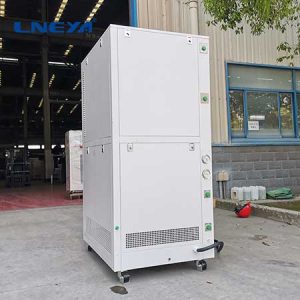What factors affect the selection of recirculating water chiller?
Generally, the FL +5°C ~ +35°C Water Chillers tube pass can be connected with water, tap water, purified water or water mixed with other substances.

It should be noted that a long time of connection with tap water will produce scale, which will have a certain impact on the flow and heat exchange effect. Therefore, it is necessary to clean regularly or add scale inhibitor in the water tower to extend the cleaning cycle.
In actual use, hydraulic oil is generally used. Of course, oil will also produce oil dirt, but the time is longer than water, so it is relatively long to clean the hand gas.
The material of water cooler tube and heat transfer tube shall be different according to the passing medium.
The main consideration here is corrosivity, and the secondary consideration is heat transfer performance. The heat transfer tube is made of stainless steel, copper tube and other materials, and the tube tube tube is made of stainless steel, carbon steel and other materials.

1. What are the factors affecting the selection of the type of industrial circulating cooling water system?
The type of industrial circulating cooling water system shall be selected according to the requirements of the production process on the quantity, temperature, quality of circulating water and the operation mode of the water supply system, and the following factors shall be combined to determine through technical and economic comparison: local hydrology, meteorology, topography, geology and other natural conditions;
Supply of materials, equipment, electric energy and make-up water; Site layout and construction conditions; The interaction between industrial circulating water cooling facilities and the surrounding environment.
2. What effect does circulating water have on the cooler?

The cooler equipment is prone to leak after a long time of use, resulting in damage to the tube bundle, tube plate and gasket, and one of the main causes of leakage is the corrosion of circulating water.
In the circulating water system, the heat exchange tube of the cooler is always filled with circulating water, or directly surrounded by the heat exchange tube. The high water vapor content at the gas inlet and high gas flow rate directly wash the tubes. Due to the uneven surface of the heat exchange tube, it is easy to form a micro-cell on the surface of the heat exchange tube, resulting in corrosion.
During the corrosion process, iron generates iron hydroxide which is precipitated from the solution and further generates iron hydroxide: 2Fe (OH) 2+1/2H2O+02 ->2Fe (OH) 3; Iron hydroxide dehydrates and forms rust: Fe (OH) 3 ->Fe00H+H2O.
The electrochemical corrosion of the metal itself has autocatalytic effect, which can accelerate the corrosion of the metal. For a long time, it will continue to corrode, which will make the wall thickness of the cooler gradually thinner, and eventually crack or perforation will occur.
 LNEYA
LNEYA
 简体中文
简体中文


















































































